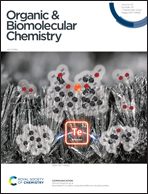Modulating chitin synthesis in marine algae with iminosugars obtained by SmI2 and FeCl3-mediated diastereoselective carbonyl ene reaction†‡
Abstract
Strategies for synthesizing polyhydroxylated piperidines such as iminosugars have received broad attention. These substances are known to interact with carbohydrate related enzymes, glycosidases and glycosyltransferases, to which also the large enzyme families of chitin synthases and cellulose synthases belong. Many chemical and biological aspects of chitin synthases remain unexplored due to the fact that modulating substances are hardly available or expensive. Starting from enantiopure D- and L-amino acids, a series of iminosugars was prepared by a Lewis acid-catalyzed cyclization of amino acid-derived unsaturated aldehydes as key step. Therefore, different Lewis acids were tested. For samarium diiodide we observed a superior stereoselectivity in comparison to iron(III) chloride and methylaluminium dichloride. To increase water solubility for testing and measurement of enzyme activity, the cyclization products were further functionalized. We established a novel biological chitin synthesis test system which allows quantitative investigation of chitin synthesis in the chitin fiber producing diatom algae Thalassiosira in vivo under the light microscope. None of the compounds displayed cytotoxicity, but two of the four iminosugars increased the length of the chitin fibers produced. This is a strong indicator that these compounds mimic carbohydrates responsible for restarting chitin polymerization.



 Please wait while we load your content...
Please wait while we load your content...